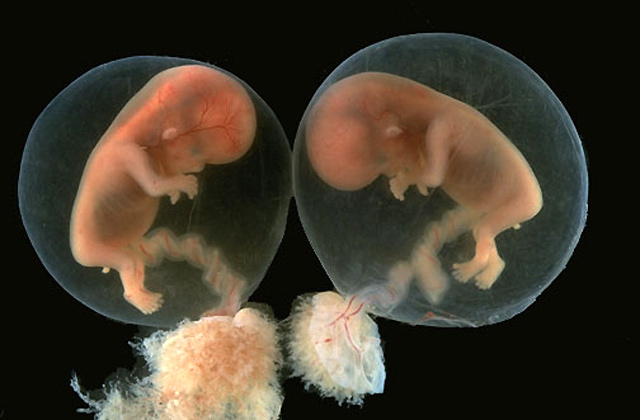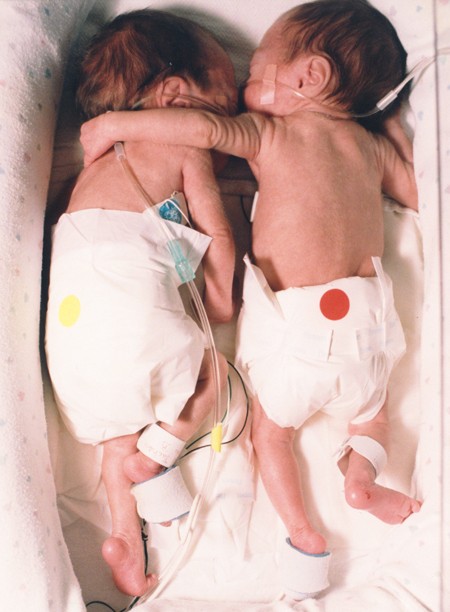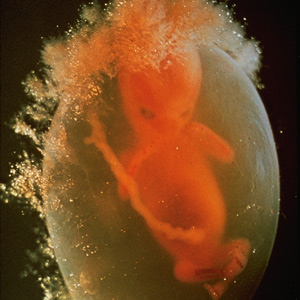Twins
Are you a twin? Do you know any twins? Twin babies grew at the same rate as a singleton until about week 28-30.
From then on, they grow a bit more slowly, either because of nutrient deficiency or crowding in the womb. Maternal health can also affect twin growth. If twins are fraternal and have their own placenta, they grow faster in late pregnancy.

Girl-girl twins and boy-girl twin pairs grow faster than boy-boy pairs. Did you know multiples, including twins, may be different sizes? This is normal, unless the size differential is 15-25%. Doctors may suggest early induced or cesarean labour.
Italian researcher Dr. Umberto Castiello of the University of Padova and associates found that twins interact with each other from early on in the womb. "Unlike ordinary siblings, twins share a most important environment – the uterus. If a predisposition towards social interaction is present before birth, one may expect twin foetuses to engage in some form of interaction," the researchers say. "We demonstrate that by the 14th week of gestation twin foetuses do not only display movements directed towards the uterine wall and self-directed movements, but also movements specifically aimed at the co-twin, the proportion of which increases between the 14th and 18th gestational week," the scientists stated.
National Geographic Twins in the womb
Move Over! Twins pushing for space in the womb
The Rescuing Hug
Kyrie and Brielle Jackson were born on October 17, 1995, a full 12 weeks ahead of their due date. The standard practice, that time, at The Medical Center of Central Massachusetts in Worcester, where the twins came into the world, was to place them in separate incubators in order to reduce the risk of infection. Both babies were placed in separate incubators, a standard practice to reduce the risk of cross-infection. Kyrie, who weighed 2lbs 3 oz, was making good progress and gaining weight, but her tiny sister had breathing and heart-rate problems, there was little weight gain and her oxygen level was low.

Photo credit - Worcester Telegram & Gazette, Copyright 1996
On November 12, tiny Brielle went into critical condition. Her stick-thin arms and legs turned bluish-gray as she gasped for air. Her heart rate soared. The Jackson parents watched, terrified that their little daughter might die.
It is said that desperate moments call for desperate measures. Nurse Gayle Kasparian, after exhausting all the conventional remedies, decided to try a procedure that was common in parts of Europe but virtually unknown in the United States. With parental permission, she placed the twins in the same bed. No sooner had she closed the incubator door, Brielle snuggled up to Kyrie and began to calm down. Within minutes, her blood-oxygen readings improved. As she dozed, Kyrie wrapped her left arm around her smaller sister. Brielle's heart rate stabilized and her temperature rose to normal.
In due time, the twins went home. Their parents placed them, once again, in the same bed where they continued to thrive. Even after five years, according to mom and dad, the twins still slept together and, not surprisingly, still snuggled.
The photograph of Kyrie hugging her little sister, dubbed the "Rescuing Hug," appeared in both Life magazine and Reader's Digest. It brought fame to the pair and spurred a growing interest in co-bedding premature twins, triplets, and quads. The University of Massachusetts Memorial, for example, has co-bedded at least 100 sets of multiple birth preemies. Observing this practice over a period of five years, the hospital staff there has not found a single case of twin-to-twin infection. In addition, clinical studies have shown that premature twins enjoy substantial benefits when they are placed in the same bed together.
Little Kyrie's hug encircles every one of us, reminding us in the most gentle of manners that we are called to participate through love in the lives of all our neighbors.
18 years later





